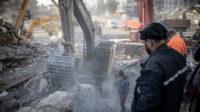
Scenes of collapsed buildings and rescuers pulling survivors from rubble once again show the acute need for seismic retrofitting and better- quality construction in Turkey.
A sense of déjà vu envelops Turkey at the start of November, with 601 dead, 4,151 injured and 3,713 buildings destroyed or uninhabitable as a result of a 7.2-magnitude quake that struck the eastern province of Van on Oct. 23.
The country lies in one of the world's most active seismic zones, perched on a web of numerous faults.
Many public buildings collapsed or were heavily damaged in the quake, including schools, dormitories, hospitals, clinics, police stations, courthouses and prisons. Damage to public facilities killed 60 teachers, two doctors and others and led to a mass prison breakout.
Multistory apartment blocks constructed of reinforced concrete with masonry infill make up as much as 80% of Turkey's urban housing and public buildings. The Earthquake Engineering Research Institute's 2003 study of housing in the country concluded that “lack of lateral resistance of the framing system resulting from poor design and construction is the principal reason for the poor performance of these buildings in recent earthquakes.”
Paradoxically, Mete Sozen, a Turkish civil engineer and a structural engineering professor at Purdue University, West Lafayette, Ind., says, “Turkey has the most modern and up-to-date earthquake construction code in the world. … Unfortunately, codes are not uniformly enforced.” He says reports indicate some of the felled buildings were built in the last five years and “should have been subject to the stringent codes.”
Turkey's current code dates from 2007. Building codes and construction requirements are similar to those in California; however, lax enforcement means the codes are widely ignored.
Semih Tezcan, a professor of civil engineering at Bogazici University in Istanbul, estimates that 22,475 schools, 6,585 hospitals and 24,335 public buildings in Turkey are waiting to be retrofitted in first- and second-degree areas of risk, adding that more than 40 years and $66 billion would be needed. The Chamber of Turkish Engineers and Architects believes as many as 40% of existing buildings are illegal. The group estimates that to prevent a future earthquake from turning into a disaster, 10% of the total housing stock needs to be rebuilt and 30% retrofitted.
Istanbul, Turkey's business and cultural capital with an estimated 14 million to 15 million residents, is particularly vulnerable because of its location on the North Anatolian Fault. According to recent assessments, the probability of a major quake hitting there within 30 years is 62%. The likelihood of massive destruction within 10 years is as high as 32%.
The high threat level spurred the city to launch in 2006 an eight-year, $864-million project aimed at increasing Istanbul's resilience to a major earthquake. The Istanbul Seismic Risk Mitigation and Emergency Preparedness Project is jointly financed by the World Bank and European Investment Bank.


Post a comment to this article
Report Abusive Comment